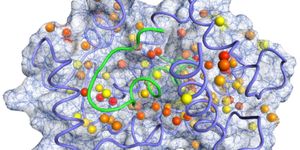A new study from the Jean Mayer USDA Human Nutrition Research Center on Aging at Tufts University (USDA HNRCA) has shown that a a type of carotenoid compound can reduce the number as well as lessen the invasiveness of tumors in cell culture and mouse models of lung cancer. The compound is called Beta-cryptoxanthin (BCX), and it is found in plants in the genus Physalis as well as orange rind, papaya and apples, for example.
In
the work, published in the journal Cancer Prevention Research, the senior scientist and director of the Nutrition and Cancer Biology Laboratory at the USDA HNRCA, Xiang-Dong Wang, M.D., Ph.D., investigated the effects of BCX by utilizing a mouse strain which grows tumors after exposure to NNK—a type of carcinogen derived from nicotine and found in tobacco products and some electronic-cigarette materials. The mice received doses of BCX in their food for two weeks before NNK exposure and 16 weeks afterwards. That intake of BCX is equivalent to what a human could get after eating a tangerine of a cup of red peppers.
Following the experiment, the researchers learned that on average, the mice treated with BCX had 50 to 60 percent fewer tumors compared to mice that had not BCX treatment, although no difference in the size of the tumors was seen. In cell culture model of human lung cancer, BCX treatment significantly lowered the migration and invasion capabilities compared to untreated cells.
These findings are in agreement with other epidemiological work correlating higher intake of BCX with a lower lung cancer risk in smokers. Additionally, Wang’s team has shown that BCX alleviates lung inflammation and emphysema from cigarette smoke and nicotine, respectively.
"For smokers, tobacco product users or individuals at higher risk for tobacco smoke exposure, our results provide experimental evidence that eating foods high in BCX may have a beneficial effect on lung cancer risk, as suggested by previous epidemiological studies. We emphasize that the best way to get BCX is from food, which include other nutrients that can have additive or complementary effects," explained Wang, who is also a Professor at the Friedman School of Nutrition Science and Policy at Tufts. "The amounts of BCX used in our study were easily achieved by eating a modest amount of sweet red peppers, pumpkin, oranges, or other BCX-rich foods."
The researchers found that the mechanism underlying the reduction in tumor number and invasiveness likely involves a nicotine receptor called alpha7 nAchR. Previous work has suggested that NNK and nicotine exposure results in the overproduction of the alpha7 nAchR nicotine receptors in lung tissue, which can trigger increases in cell growth and migration, raising the risk of tumor formation. The new study shows that mice treated with BCX had about half the level of alpha7 nAchR after being exposed to NNK, compared to untreated mice. BCX seems to suppress alpha7 nAchR expression and associated cellular growth- and migration-promoting pathways, and does not affect cells that don’t have alpha7 nAchR rceptors.
"Our study is the first to demonstrate that BCX prevents overproduction of the alpha7 nicotine receptor, which represents a possible mechanism for how BCX inhibits the development of lung tumors," Wang said. "While we believe BCX has preventive or therapeutic potential against lung cancer, additional studies are required as human biology cannot be fully mimicked by cell and animal models. We are now further investigating the molecular interactions between BCX and lung cancer, and exploring the possibility for small-scale human clinical trials."
Like other provitamin A carotenoids, alpha- and beta-carotene, the human body metabolizes BCX into vitamin A. It is known that supplementation of some forms of vitamin A and beta-carotene is actually associated with an increased risk of lung cancer, while beta-carotene supplementation has no preventative effect. Wang’s team fiound that the preventative influence of BCX is probably unrelated to biological vitamin A and unique to the BCX itself. They are continuing to study the process.
According to the USDA, the foods highest in BCX include paprika, persimmons, tangerines, papaya, peaches, oranges, butternut squash and sweet red peppers. The brief video above has more about carotenoids.
Sources:
AAAS/Eurekalert! via
Tufts University,
Cancer Prevention Research,
Wikipedia









